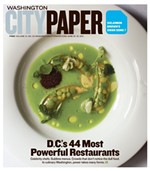Cracking Up the Code
Dan Brown and his various publishers aren’t complaining, but the massive success of The Da Vinci Code—60 million copies sold and counting—has long seemed like a distraction. With its headlong gait, compressed time line, and tiny cast of characters, the novel was always meant to become a Hollywood movie. But it turns out that the book’s success has not only delayed the film, but also undermined it. Because Brown’s conspiracy-minded rewrite of Christian history has only gotten more controversial in the three years since its release, the prudent choice for a filmmaker hoping to reach the widest possible audience would be to make a movie that essentially betrays the novel—which is just what director Ron Howard and scripter Akiva Goldsman have done.
The Da Vinci Code is not, of course, a good book. It’s clumsily written and humorless, and it makes a hash of history and theology. But whether Brown’s goal was simply to write an Umberto Eco novel for the masses or to brashly shake the foundations of Christianity, the book has filled a need. It knocked the cobwebs from centuries of dogma and put the “facts” of Western religion in play for millions who had never questioned them. So does the movie, after a fashion. Howard and Goldsman retain the novel’s basic plot, as well as its heretical—if not especially disturbing—conclusion.
For the first half of the film’s two and a half hours, the filmmakers mostly just compress the story, eliminating false steps and second guesses and rendering events even speedier than in the briskly paced book: Late one night in Paris, American professor of religious symbology Robert Langdon (Tom Hanks) is summoned to the Louvre. There, venerable curator Jacques Saunière (Jean-Pierre Marielle) managed to leave an abundance of clues to his secret mission while dying from a gunshot wound inflicted by killer monk Silas (miscast Paul Bettany). As driven French cop Bézu Fache (ever-feral Jean Reno) questions Langdon, winsome police cryptographer Sophie Neveu (Audrey Tautou) arrives, secretly warning the American that he’s about to be unjustly charged with Saunière’s murder. Neveu helps Langdon escape the museum, and together they pursue Saunière’s clues, which indirectly lead to the chateau of British scholar Leigh Teabing (Ian McKellen), and on to London. At stake, as you might have heard, are the Holy Grail, The Last Supper, and the divinity of Jesus.
Howard, who first hooked up with Hanks for the big-screen sitcom Splash, might not seem like the guy to handle such material. But his style has gotten darker over the years, and he and Goldsman collaborated on A Beautiful Mind, which also explored the danger lurking in ideas. As in that film, bits of information pulsate to show that someone (usually Langdon) is thinking about them. Howard clearly fears static images and long passages of expository dialogue, so most speeches about personal or religious history are illustrated by brief, agitated flashbacks to a past characterized by desaturated color and low production values. Wham! The crusades! Bang! The persecution of witches! When Neveu explains the design of a cryptex, a sort of booby-trapped combination lock, the camera rockets inside to show its workings.
There’s a lot of information here—some factual, much conjectural—and including so much of it inevitably overpowers the movie’s attempts to thrill. The Da Vinci Code comes on strong at first, with swooping camera, frantic cross-cutting, and the introduction of Silas’ blood-spattered devotional routines. Once the characters leave the Louvre, however, Goldsman’s rewrites introduce annoying incoherencies and the tension slackens. (Besides, nothing can top Silas’ self-flagellation, which is by far the movie’s creepiest bit.)
Hanks traditionally plays good-guy leads, so Howard’s decryption of The Da Vinci Code does require a few dilutions of the source material. In the book, Langdon and Neveu are equally matched, complementing each other’s areas of expertise and trading forensic riffs as if one of the Hardy Boys were a Frenchwoman. In the movie, however, knowledge is a man’s world. It’s Neveu’s role to stand there, dazed and bemused, as Langdon and Teabing lecture her on the power of the sacred feminine. As a screen presence, Tautou has never looked less powerful.
But that’s not the script’s most important bit of behavior modification. In order to protect Hanks’ mass-market likability, Langdon has become more skeptical of the very points that seem most important to Brown, which include a characterization of Jesus similar to the one that brought picketers to theaters showing The Last Temptation of Christ almost 20 years ago. In the book, as Teabing deconstructs the Roman Catholic worldview, Langdon adds his assent. In the movie, he challenges Teabing’s interpretation, pointedly rejecting or dismissing some of the ideas that most upset Brown’s detractors. When Teabing advances one of his (and the novel’s) more heterodox notions, Langdon barks, “This is an old wives’ tale!”
It could be argued that because so many people have read the novel, it makes sense to rewrite the scenario simply to avoid boring viewers. But boredom doesn’t seem to be the reaction that most concerned Howard and Goldsman. As the movie progresses, it deviates even further from its source—and not just narratively. It doesn’t jettison the novel’s most argued propositions, but it does significantly soften them, until Langdon is left murmuring such homilies as “the only thing that matters is what you believe” and suggesting that sensational new information about Jesus should “renew” Christian faith.
Such backpedaling won’t be enough to satisfy the most outraged naysayers, but it’s sufficient to turn the film’s final revelations to mush. The Da Vinci Code has been handled as a potential thunderbolt, with the film shrouded in secrecy and armored by a marketing campaign designed to co-opt religious opponents. But the explosion fizzles, and in a way that’s altogether typical of Hollywood adaptations: Though the movie intensifies the book’s violence, what really gets murdered are its ideas.

